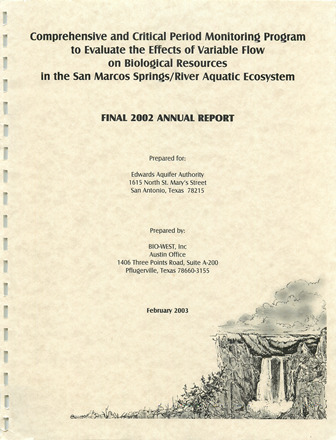Comprehensive and Critical Period Monitoring Program to Evaluate the Effects of Variable Flow on Biological Resources in the San Marcos Springs/River Aquatic Ecosystem Final 2002 Annual Report

| Author | BIO-WEST, Inc |
| Year | 2003 |
| Description | Annual report for 2002 on biota study of San Marcos Springs/River |
| Publisher | BIO-WEST Inc |
| Location | San Marcos Springs/River |
| Summary |
|
The purpose of this report is to document the results of all aquatic ecosystem monitoring conducted in 2002 at San Marcos Springs located in San Marcos, Texas. The monitoring and report preparation was performed by BIO-WEST, Inc. Pflugerville, Texas. [Excerpted from Executive Summary] Baseline data have continued to show that the San Marcos River is an ecosystem with very high water quality according to the chemical and physical variables that were measured. …Aquatic vegetation remained abundant throughout the study period and provided suitable habitat for biological communities…. Following high-flow conditions during the summer, considerable impacts to the aquatic vegetative communities in the San Marcos River were observed; large areas of vegetation were removed or significantly thinned in all reaches. … As in previous high-flow sampling events, fountain darters appeared to Texas wild-rice total coverage increased overall in the time period between the fall 2001 and summer 2002 high-flow events (-9%, >158 square meters [m2]), but decreased in all reaches between the spring and summer sampling events (mean decrease -22%). These data continue to suggest that scouring events are beneficial overall to Texas wild-rice despite significant short-term decreases in overall coverage. … The number of fountain darters per drop-net sample in the San Marcos River was much lower than in the Comal River. …No giant ramshorn snails were observed in the San Marcos River in 2002. However, because of the potential for a rapid population increase and the impact that this exotic species can have under heavier densities, close monitoring should continue. The gill parasite that has been reported to infect the fountain darter in the Comal system was not visually evident in fountain darters collected from the San Marcos system. … Estimated population densities of the San Marcos salamander in 2002 were consistent with observations in 2001. Filamentous algae remained abundant throughout 2002 and each sampling event conducted in the Hotel Reach and the deep site in Spring Lake required clearing the algae prior to sampling efforts. This may have impacted sampling efficiency. Regardless, the sample site adjacent to the former Aquarena Springs Hotel consistently had the highest number of San Marcos salamanders. … More data from periods of low-flow (particularly from an extended period of low-flow) are essential to fully evaluate the biological risks associated with future critical periods (high or low-flow). Although quarterly sampling does not yield the vital low-flow data, these samples are extremely important to maintain a continuous understanding of current conditions in order to be prepared for a period of low-flow and to monitor conditions following such a period. Sampling only during a low-flow event will not provide the necessary context to adequately assess changes that occur during such conditions. |
Search for Documents
Advance Search
Explore EAA's Scientific Reports
- All Reports
- Weather Modification
- Geology
- Water Use and Conservation
- Geochemistry
- Water Resources Planning and Management
- Floods and Drought
- Water Quality
- Climatology
- Surface Water / Groundwater Relationship
- Biology
- Springs, Groundwater Discharge
- Archaeology
- RZ Protection
- Aquifer Levels
- Remote Sensing
- Precipitation
- Overview Studies
- Modeling
- Hydrology and Hydrogeology
- History
- Groundwater Recharge, Recharge Zone
- Groundwater Movement
- Geomorphology and Caves
